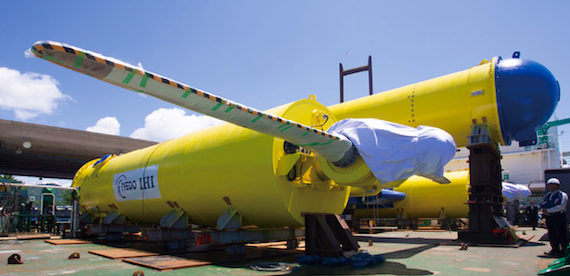Ann Arbor (Informed Comment) – If you were going to try to generate electricity from a deep water ocean current, you’d like it to be flowing in one direction and to be fast and steady. Most deep sea currents are unidirectional because of the earth’s rotation. and this tendency is reinforced where they flow through narrow undersea gaps. Those desiderata are not easily met for most countries, but Scotland and Japan both have such currents. And the Japanese turbine and infrastructure company IHI has created an underwater turbine that can take advantage of Japan’s swift deep sea currents, called Kairyu.
In a recent paper, Ryo Fujiwara et al. note that energy from the sea is promising, saying, “the potential estimate for tidal energy was given as 3TW [3 terawatts]. Ocean energy plants have merits: the equipment space does not require land use, which can be expensive or scarce, and the energy density is higher than air.”
They add, “In Japan, there are developments to harness energy from the ocean. In the southern region of Japan, there is a 100 kW class prototype subsea floating type ocean current power generation system “Kairyu.” The demonstration test of Kairyu was conducted in the waters off the coast of Kuchinoshima, Toshima, Kagoshima Prefecture.”
Japan’s agency for promoting new technology, NEDO, which has been partnering with IHI on the project since 2011, explains of Kairyu, IHI’s undersea turbine, “By taking sea water in and out of the device balances buoyancy and controls the depth of the device autonomously. Maintains stabilized position by turning two sets of blades in the opposite direction.”
IHI carried out its tests with the Kuroshio Current, which flows northeast along Japan’s Pacific coast. It is one of the world’s fastest such currents, NEDO explains.

Kairyu Turbine, courtesy NEDO.
The results of the Kairyu experiment have been positive. Deep sea currents are so steady that you cannot really call them intermittent, and so they can provide baseline electricity and reduce the need for battery storage that solar and wind require.
Romain Mahet writes that the Kuroshio Current alone could generate 200 gigawatts of electricity for Japan.
Fujiwara et al. point out that the Kuroshio current is not the only promising one in Japan for these purposes. They write, “The Tsugaru strait, in the northern region of Japan, is an area that has attracted attention for the utilization of tidal/ocean energy. Unidirectional tidal and ocean flow with high energy density drifts between the main island and Hokkaido Island. Energy harvesting, equipping multiple tidal/ocean power generators in The Tsugaru strait, has shown to be effective.”
Erica Yokoyama at Bloomberg notes that exploiting deep ocean currents doesn’t interfere with shipping, unlike tidal power arrays on the surface, and IHI is doing environmental impact studies. The big question is whether IHI’s turbines can compete cost-wise with wind and solar as the latter fall in price. At the moment she estimates that it is only slightly more expensive than those two. That extra expense may be offset, though, by the lack of need for battery storage.


 © 2025 All Rights Reserved
© 2025 All Rights Reserved